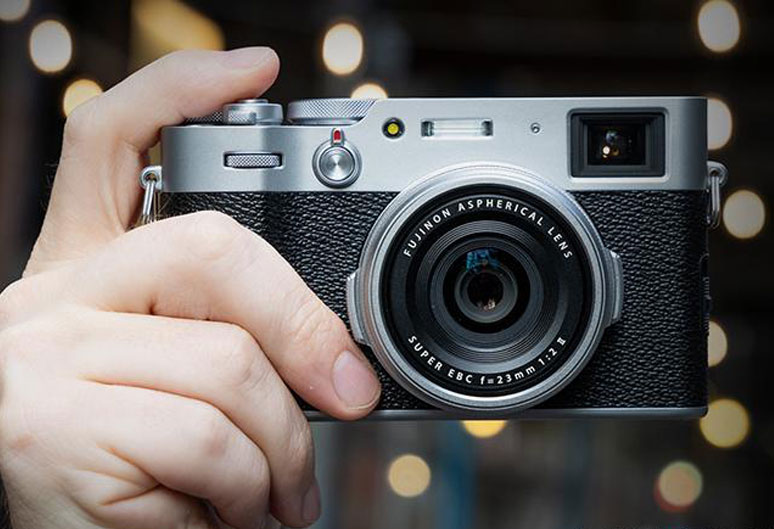There are plenty of situations in which you might not want to use your big, bulky pro-spec DSLR. Taking photos is fun, whether it’s just grabbing a few street shots on a Sunday, or grabbing some images on holiday, and in these kind of situations, a backup second camera, something pocketable and self-contained, is a tremendous thing to have. It can also have professional uses too, allowing you a quick way to grab behind-the-scenes images or encouraging you to shoot with a different perspective.
Here, we run through some of our recommendations for pocketable second cameras you can carry everywhere with you.
Fujifilm X100 series
These are arguably the archetypal second cameras on the market right now. The series currently numbers four models — the original X100, the X100S, the X100T and the X100F, which was released at the start of 2017. All share a fixed focal-length 23mm lens (35mm in equivalent terms), and later models have been upgraded with more recent iterations of the X-Trans sensor. The X100F especially was a serious upgrade, using the X-Trans III sensor and the X Processor Pro, resulting in snappy focusing times with significantly better focus tracking.

So what is it about this series that photographers enjoy so much? Our friends at Wex Photo Video interviewed a few pros about why they love this series so much https://www.wexphotovideo.com/blog/features/Why-Photographers-Love-the-Fujifilm-X100-Series/, and the responses were interesting. Photographers praised the tactile, dial-led controls, the pocketability of the cameras, the optical/electronic hybrid viewfinder, the film simulation modes that produce beautiful images straight out of camera. For some of them, the X100 cameras have even found a place in their professional workflow, despite their fixed focal lengths.
Panasonic TZ series
These compacts have established a well-earned reputation for being useful, all-rounder travel cameras (the TZ denotes ‘travel zoom’), and they make perfect pocketable companions. The series currently comprises the TZ70, TZ80, TZ90, TZ100 and TZ200. The range offers a pleasing variety of configuration, allowing you to pick your model to taste. For example, the triple-digit cameras both come sporting larger 1-inch sensors, compared to the 1/2.3-inch MOS sensors of the others; however, the double-digit models offer a greater zoom range of 30x (24-720mm, 35mm equivalent) compared to 10x (25-250mm) on the larger models. It’s a matter of personal preference.

Elsewhere, these cameras pack a lot into their light bodies. All come with 5-axis image stabilisation, and all save the TZ70 are able to record 4K video, and given that these are Panasonic Lumix models, can also use 4K Photo modes to extract 8MP stills from footage. They’re terrific travel cameras for a multitude of reasons, not least of which is the full Wi-FI connectivity present on every model — perfect for sharing shots.
Sony RX100 series
Since casually redefining the possibilities of the small compact camera with the original RX100 back in 2012, Sony has not rested on its laurel. Six years later and we are on the sixth iteration of the format, with the RX100 VI making its debut in 2018. Unusually, all six cameras are still widely available — the simple reason for this is that any one of them would make a worthy addition to any photographer’s kit bag.
The original RX100 turned the industry on its head by cramming a 20.1MP 1-inch Exmor CMOS sensor into a relatively small body, pairing it with a high-quality 28-100mm lens to make for a versatile, do-everything compact camera that can hold its own with the big boys. Subsequent models have more or less kept to this formula (with a little departure in the VI, which we’ll get to in a moment), and they improve incrementally in the ways you might expect, with higher ISO ranges, wider lens aperture, better processing times etc. The great thing about all the cameras being available (and of superb quality) is that you can balance your budget against the features you want and/or can live without and make a decision accordingly.

Finally, a word on the RX100 VI. Sony took a bit of a departure with this one and managed to get a telephoto lens in there, upping the focal length to 24-200mm, significantly more than the 24-100 and 24-70 ranges of the previous models. If you want the extra reach, it’s a solid bet.
Canon EOS M series
Many photographers enjoy the feel of a DSLR too much to give it up. If you want that DSLR handling to be present and correct even in your second camera, then the Canon EOS M series is worth looking into.
The series started with the original EOS M back in 2012, and has since grown with the EOS M5, M6, M50 and M100. The M5 is the mirrorless flagship, with others in the series offering a more slimmed-down experience, with prices to match. All feature high-quality sensors, and the EOS M50 is capable of shooting 4K video, making them more than a match for other cameras of their class.

Lens-wise, these camera use the EF-M mount, a pleasingly broad range that encompasses slim wide pancakes, longer telephotos and everything in between. If you’ve already got a hefty collection of Canon glass, you can also adapt it to your EOS M camera with the EF-EOS M mount adapter. This versatility and flexibility makes the M series an especially good choice of second camera for Canon users, whether it’s as a smaller camera to pack for a casual day out, or as a second camera on a professional shoot.

